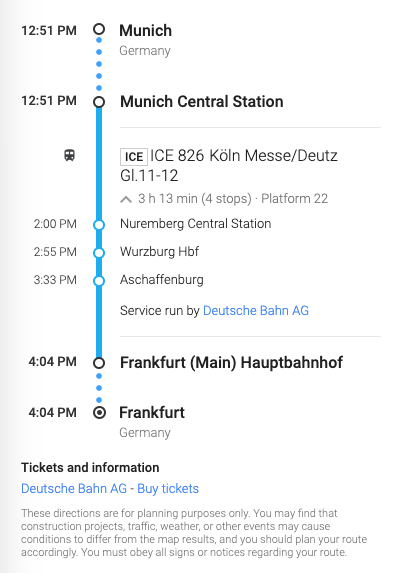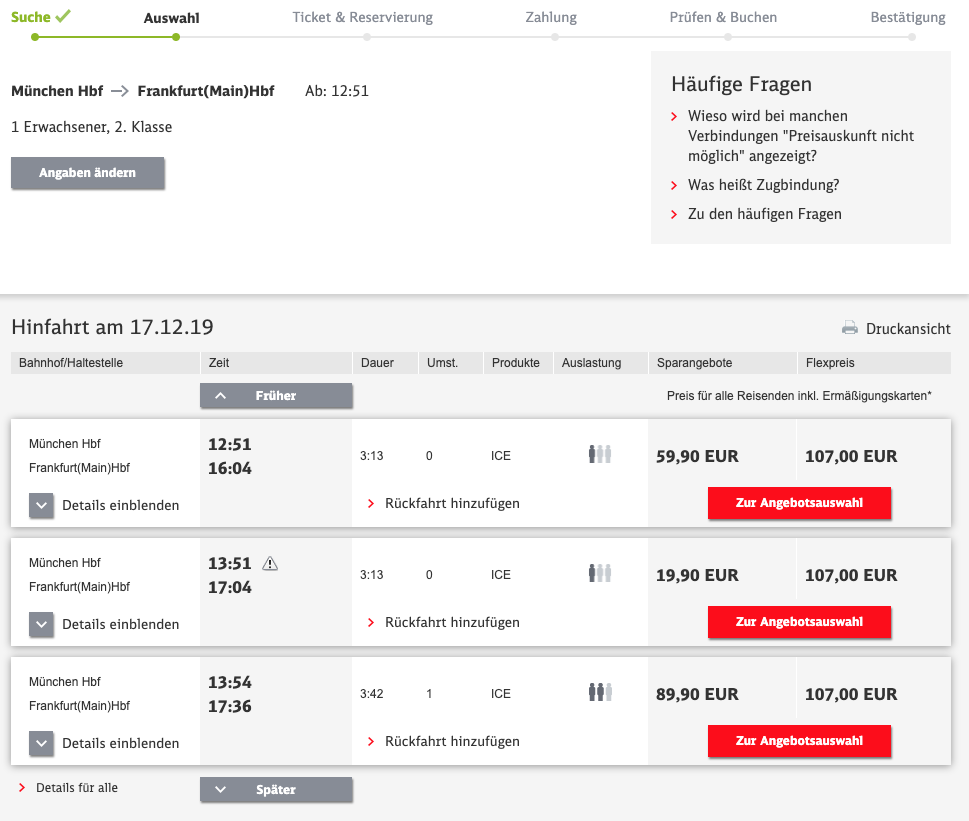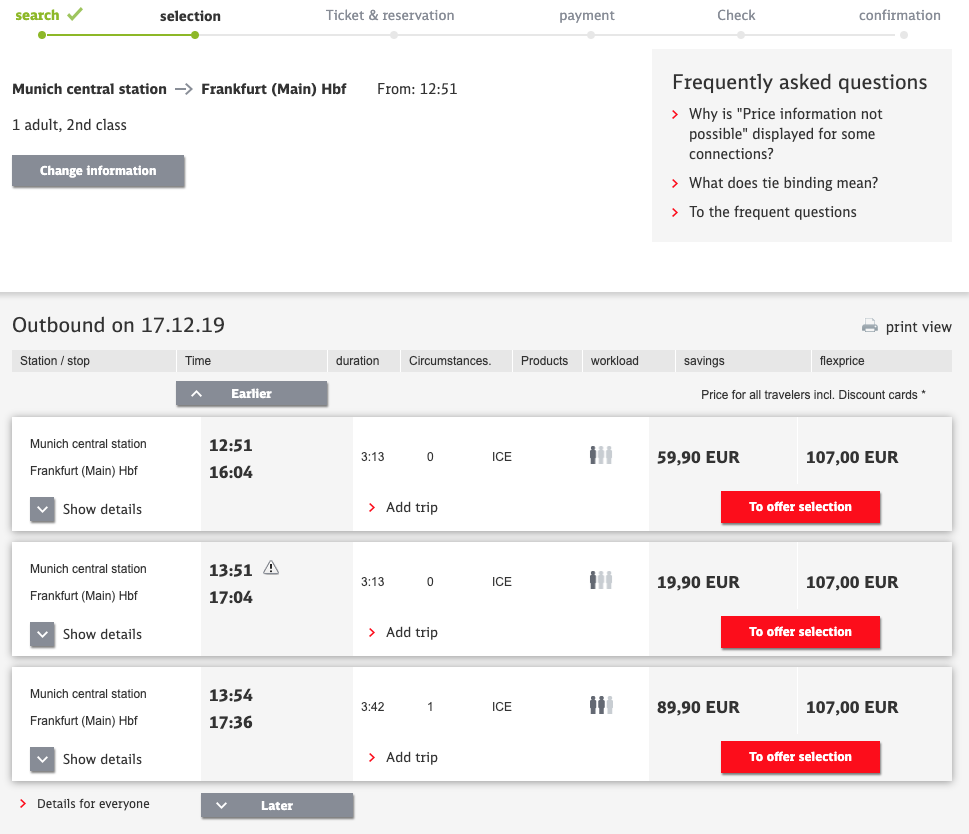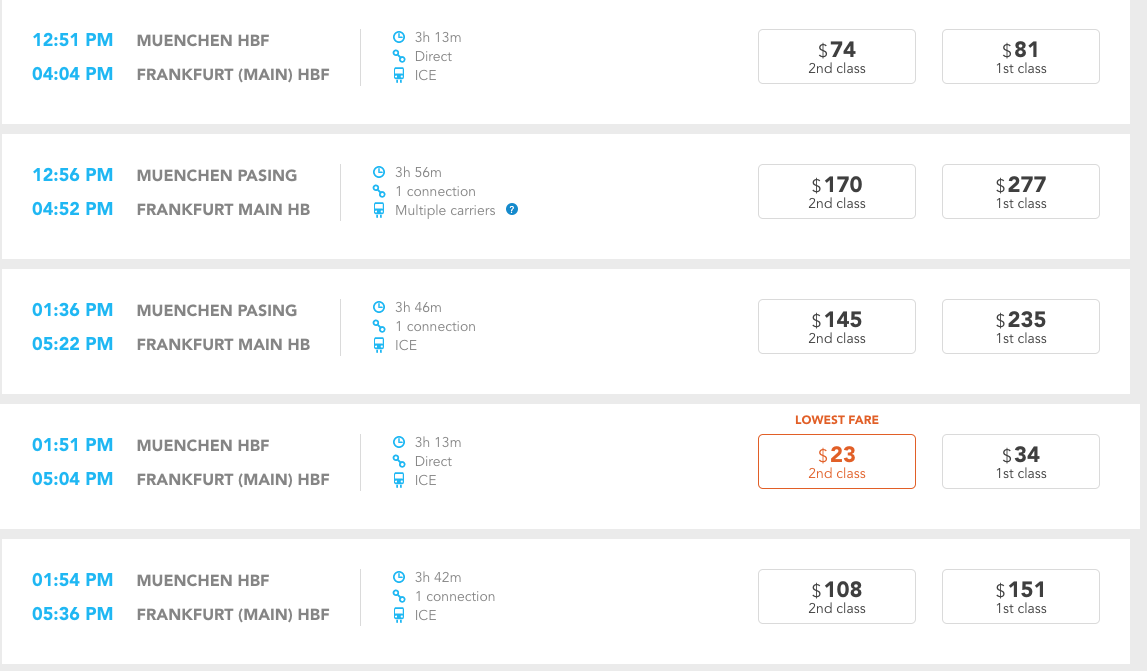Google Maps, along with other map apps, has made traveling from one place to another much easier than it used to be. All you need to do is type in your starting place and destination and you’ll get detailed information on how to get there. If you’re looking at taking a train, if you input your departure time, you’ll even get a selection of trains you can take.
However, Google Maps leaves out one important piece of the puzzle, the price of a ticket. If you truly want to comparison shop, you’ll need to know how much a ticket on each train will cost. A local train will be cheaper than express or high-speed options. So how can you find out the price?
It’s not easy.
Take a trip from Munich to Frankfurt.

If you click on the hyperlinks, you’ll go to the website of the railway running the train. Clicking on the “buy tickets” link will take you right to the purchase page on the Deutsche Bahn website.

I don’t speak German and I don’t want to buy a ticket when I can’t understand anything on the webpage. Fortunately, if you’re using the Chrome browser, it can translate the site for you.

That’s much better. Of course, if you want to see the entire site in English, you can start on the home page and change the language setting. No chance of Google mistranslating something and you accidentally buying tickets for the wrong train.

Of course, if this is too overwhelming, you can always just buy a ticket at the station. However, if you’re traveling during a busy season, seats on the train might be sold out or only have the expensive ones left.
While doing my research, I found another option available for those who just want a one-stop-shop for their train tickets. There’s a website called Rail Europe and it looks like it’s the Expedia of rail tickets.
Just type in your cities and the travel date and number of passengers.

Here are the results of the same search as above.

There’s also a toggle bar at the top of the screen where you can narrow the time, connections, type of train and price. You can also set it only to show flexible tickets, which you can use on a different train than the one you booked. Otherwise, your ticket is only good on the one you reserved.
No worrying about Euros or converting the time from a 24-hour clock to the 12-hour version we use in the U.S. You also don’t have to worry about ticket types and names you can’t pronounce. All of the ticket restrictions are clearly spelled out when you make the reservation. For this convenience, they do charge more than if you’d buy direct from the railway. For the above ticket, the fee was $7.95.

I view this the same as buying a ticket from a travel agent. They take away the guesswork about your purchase and for that convenience, you pay them a little bit extra. If you’re someone who’s not familiar with European rail lines, like us, this doesn’t seem like too much more to pay.
Final Thoughts
Technology makes it possible to do things yourself that used to be impossible. I’d never even consider trying to book a train ticket on a German website, even if I was using Babel Fish to translate (remember that website? Here’s what happened to it) (Note from Sharon: OMG, I remember Babel Fish! Hey, speaking of old computer stuff, did you know that you can still play Commander Keen online?). Even using the English version of a website, there’s still little idiosyncrasies when booking tickets in a different country. Using a website that lets you search in English in a format familiar to you might be an appealing option, as long as you understand you’ll be paying extra for the convenience.
Like this post? Please share it! We have plenty more just like it and would love if you decided to hang around and clicked the button on the top (if you’re on your computer) or the bottom (if you’re on your phone/tablet) of this page to follow our blog and get emailed notifications of when we post (it’s usually just two or three times a day). Or maybe you’d like to join our Facebook group, where we talk and ask questions about travel (including Disney parks), creative ways to earn frequent flyer miles and hotel points, how to save money on or for your trips, get access to travel articles you may not see otherwise, etc. Whether you’ve read our posts before or this is the first time you’re stopping by, we’re really glad you’re here and hope you come back to visit again!
This post first appeared on Your Mileage May Vary

4 comments
Thanks for the warning that buying a ticket at the station may leave one with either no seat or only expensive seats. How about for shorter trips, like Paris-Lille?
Rome2Rio is another alternative that I’ve found helpful. The passenger in seat 61 is pretty good for train stuff as well.
So I just got back last week from a Germany and Switzerland, and rode the trains in both countries. My two cents: get a DB account before you go. If you know the dates of travel and can commit to non refundable tickets, buy them in advance. I paid 35 euro for a first class seat from Wiesbaden to Rheinfelden (near Basel); of course, Wiesbaden to Mainz was 2nd class, but that’s only 20 minutes. The rest of the ride was south with one train change in Mannheim, and a local train from Basel to a Rheinfelden. But first class with a reserved seat most of the way. You need to look for the spar preis option which is the discounted, but non changeable fare. I rode from Interlaken Ost to Wiesbaden 2nd class (no reserved seat) for 25 euros. If you buy the walk up fare, it can top 160 euro each way. Worth researching. The Swiss SBB site doesn’t appear to have an app, but does have English. Unfortunately I could never get the purchase to go through. For example, I traveled fro Lucerne to Wengen, at it showed a discount price of about 13 franc, but I could not make it work. Bought the ticket at the station for 33 francs. I recommend the DB site with an account for German travel for sure. And check for spar preis!
Now that every carrier in Europe has a good English website, that should be the first stop for booking. Third party sites not only charge a fee, but they also don’t necessarily have the best promo rates.
Also, a key tip for trains crossing national boundaries is to check the website for both national carriers, they price tickets differently! For example, taking a trip from Czech Republic to Austria, the former’s CD website is typically half the price of the latter’s OBB, for the exact same train.